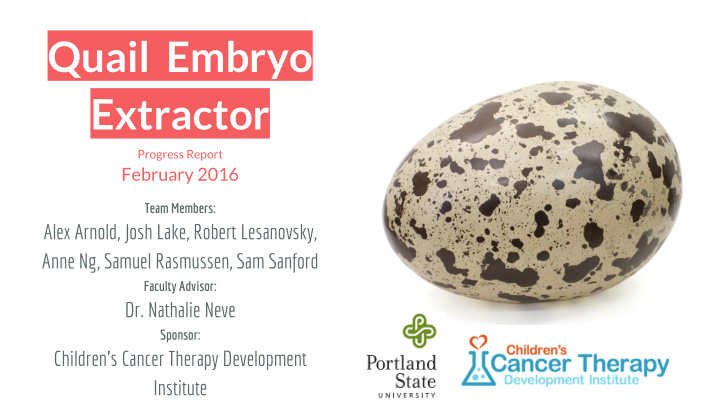



Quail Embryo Extractor Progress Report February 2016 Team Members: Alex Arnold, Josh Lake, Robert Lesanovsky, Anne Ng, Samuel Rasmussen, Sam Sanford Faculty Advisor: Dr. Nathalie Neve Sponsor: Children’s Cancer Therapy Development Institute
Overview Summary ● Where we are in the timeline ● Design questions that needed answered ● Robert’s Field Trip ● Concept Development ● Design Features ● Next Steps ● Selection Process ● Q&A ●
Summary ● Objective: Design and produce a device that safely removes the embryo of a quail egg for cancer research by Children’s Cancer Research institute. Device must have an extraction rate of greater than one egg per minute and a 90% success rate ● Current Process of extraction is time consuming (about one egg per minute) and has a success rate of about 50%
Where we are in the timeline ● Finished with External and Internal research Researched existing products for chicken eggs ○ Brainstormed possible methods of extraction ○ ● Currently on schedule, midway through concept development Have explored each individual team member’s prototype concept and have found common features ○ ● Fast approaching concept evaluation and selection ● Some design features need further development before we can proceed to detailed engineering
Questions That Needed to be Answered in order to Proceed ● Required orientation of the Egg ● Where to make puncture to not damage embryo ● Sanitation concerns with puncturing shell ● How to determine a successful extraction
Robert’s Field Trip Concept Validation
Robert’s Field Trip ● Suction Cup Concept Validation How was the prototype used? ○ Answered important questions ○ ● Important factors of Extracting a Quail Egg Embryo Difference between fertilized and unfertilized quail eggs ○ Determination of a successful extraction ○ Orientation ○ Sanitation ○
Concept Development Individual group member’s Ideas
Design Features ● Egg held horizontally with suction ● Puncture made on bottom of the egg to protect embryo ● Puncture device to move away quickly after puncture This is so the embryo does not land on it ○ ● Could be hand-held and/or hand-operated This would take away the need for a motor ○ ● A moment could be applied to open the crack The same method Robert used at the lab ○
Next Steps Concept Evaluation and Selection
Next Steps ● In order to proceed, we need to decide: ○ Method of creating a vacuum ○ Selection of a sanitary puncturing method ○ Extraction quantity
Method of Creating a Vacuum Motorized Pump Manual Piston Bellows Suction Cup
Method of Creating a Vacuum Motorized Pump Advantage: ● Can produce constant, adequate vacuum ○ Less concern if vacuum is leaking ○ Disadvantage: ● Noisy operation ○ Relies on external source of energy ○ Takes up space (Motor) ○
Method of Creating a Vacuum Manual Piston Advantage: ● Silent Operation ○ No motor required ○ Disadvantage: ● Requires large piston to produce sufficient vacuum ○ Difficult to implement ○
Method of Creating a Vacuum Bellows Suction Cup Advantage: ● Silent operation ○ Simple ○ Easy implementation ○ No motor required ○ Disadvantage: ● May not be able to produce adequate vacuum ○
Selection of a Sanitary Puncturing Method ● Cross contamination Cross contamination is not a big concern. ○ Ideally, cross contamination should not occur. ○ ● Cleanability: Cutters should be easily detachable and cleanable. ○ ● A method that would crack the shell but not damage the embryo. Cushioned hammer with metal point ○ Pure separation force ○ A wedge ○ Lancing device (diabetes testing) ○ Lasers? ○
Extraction Quantity ● Single Egg Handheld device ○ ● Multiple Eggs Handheld device converted into an automated array ○ ● Trade-offs Complexity ○ Speed ○ Cost ○
Questions?
Recommend
More recommend